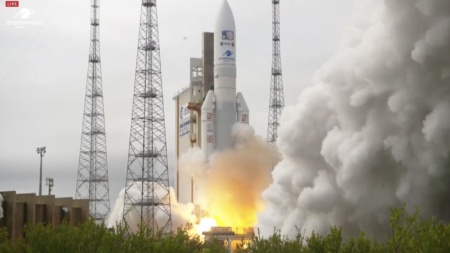
The European Space Agency launched an Ariane 5 rocket from Kourou, French Guiana. Thus, the mission to study the satellites of Jupiter was launched.
The rocket launched the 6-ton Jupiter Ice Moons Explorer (JUICE) spacecraft into space. This is ESA’s largest deep space exploration mission. The spacecraft was built by Airbus Defense & Space and cost €1.5 billion.
The idea for the JUICE mission arose after NASA’s Galileo and Cassini probes discovered that some of the moons of Jupiter and Saturn are covered in ice. They are also likely to contain large subsurface oceans in which microbial life may exist.
“The next logical step was to return to Jupiter with improved equipment to study these oceans in detail,” said Nicola Altobelli, a planetary scientist at the European Space Agency who was involved in the development of the JUICE mission. “With that in mind, we wanted to see if they were possible habitats for life.”
The JUICE spacecraft is quite massive and will need several flybys of planets to accumulate energy to reach the Jupiter system. After its launch, JUICE will fly past Earth three times, as well as Venus, before entering orbit around Jupiter. This will happen only in 2031. Then, from 2031 to 2034, it will make nearly three dozen flybys of Ganymede, Europa, and Callisto, studying their icy surfaces in detail.
JUICE will approach some space objects to a distance of 200 km, which will allow them to be examined better. The ship is equipped with a high-resolution optical camera, spectrometer, magnetometer and other research instruments. The mission’s scientific goals also include understanding the formation of Jupiter’s moons, their development, and the changes that led to their differences from each other.
At the end of 2034, after many orbits around Jupiter, JUICE should enter orbit around Ganymede, where it will remain for another year. It will be a difficult maneuver to enter the orbit of a satellite of another planet. As Nicola Altobelli points out, Ganymede is a very interesting moon with its own magnetic field and probably an internal ocean. ESA hopes to “conduct the most detailed analysis of the interior of the moon.”




